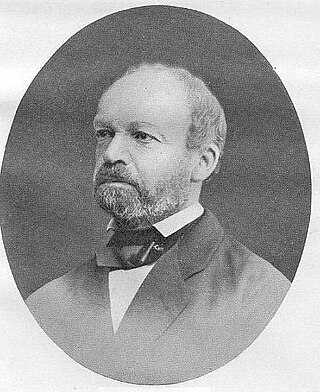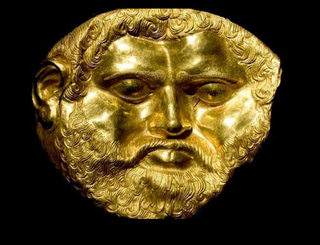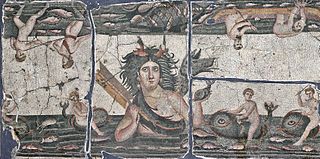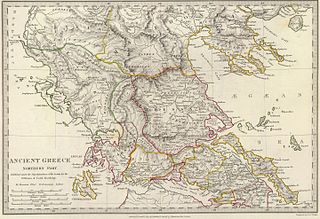Related Research Articles

Wilhelm Siegmund Teuffel, German classical scholar, was born at Ludwigsburg in the Kingdom of Württemberg. In 1849 he was appointed extraordinary, in 1857 ordinary professor in the university of Tübingen, which post he held till his death.
The Oxford Classical Dictionary (OCD) is generally considered "the best one-volume dictionary on antiquity," an encyclopædic work in English consisting of articles relating to classical antiquity and its civilizations. It was first published in 1949, edited by Max Cary with the assistance of H. J. Rose, H. P. Harvey, and Alexander Souter. A second edition followed in 1970 (OCD2), edited by Nicholas G. L. Hammond and H. H. Scullard, and a third edition in 1996 (OCD3), edited by Simon Hornblower and Antony Spawforth. A revised third edition was released in 2003, which is nearly identical to the previous third edition. A fourth edition was published in 2012 (OCD4), edited by Simon Hornblower, Antony Spawforth, and Esther Eidinow. In 2016, a fully digital edition launched online, edited by Sander Goldberg (2013–2017) and Tim Whitmarsh (2018–present). Continuously updated on a monthly basis, this edition incorporates all 6,300 entries from OCD4 as well as newly commissioned entries, and features multimedia content and freely accessible maps of the ancient world.

The vigintisexviri were a college (collegium) of minor magistrates in the Roman Republic. The college consisted of six boards:
The Peripatetic school was a philosophical school founded in 335 BC by Aristotle in the Lyceum in Ancient Athens. It was an informal institution whose members conducted philosophical and scientific inquiries. After the middle of the 3rd century BC, the school fell into decline, and it was not until the Roman Empire that there was a revival.

In Roman religion, Terminus was the god who protected boundary markers; his name was the Latin word for such a marker. Sacrifices were performed to sanctify each boundary stone, and landowners celebrated a festival called the "Terminalia" in Terminus' honor each year on February 23. The Temple of Jupiter Optimus Maximus on the Capitoline Hill was thought to have been built over a shrine to Terminus, and he was occasionally identified as an aspect of Jupiter under the name "Jupiter Terminalis".
Hecataeus of Abdera or of Teos, was a Greek historian who flourished in the 4th century BC. Though none of his works survive, his writings are attested by later authors in various fragments, in particular his Aegyptica, a work on the society and culture of the Egyptians, and his On the Hyperboreans. He is one of the authors whose fragments were collected in Felix Jacoby's Fragmente der griechischen Historiker.

The Via Aurelia is a Roman road in Italy constructed in approximately 241 BC. The project was undertaken by Gaius Aurelius Cotta, who at that time was censor. Cotta had a history of building roads for Rome, as he had overseen the construction of a military road in Sicily connecting Agrigentum and Panormus.

Teres I was the first king of the Odrysian kingdom of Thrace. Thrace had nominally been part of the Persian empire since 516 BC during the rule of Darius the Great, and was re-subjugated by Mardonius in 492 BC.
Spurius Carvilius Ruga was the freedman of Spurius Carvilius Maximus Ruga. He is often credited with inventing the Latin letter G. His invention would have been quickly adopted in the Roman Republic, because the letter C was, at the time, confusingly used both for the /k/ and /g/ sounds. For example, Ruga's own name contained this confusion: SPVRIVS CARVILIVS RVCA. In the latter half of the 3rd century B.C., Ruga is the first man in recorded history to have been attested as opening a private elementary school, although other such schools may have existed in Rome prior to his.

Thalassa was the general word for 'sea' and for its divine female personification in Greek mythology. The word may have been of Pre-Greek origin.

Hellenic is the branch of the Indo-European language family whose principal member is Greek. In most classifications, Hellenic consists of Greek alone, but some linguists use the term Hellenic to refer to a group consisting of Greek proper and other varieties thought to be related but different enough to be separate languages, either among ancient neighboring languages or among modern varieties of Greek.
Lamachus was an Athenian strategos or general in the Peloponnesian War. He commanded as early as 435 BCE, and was prominent by the mid 420s. Aristophanes caricatured him in The Acharnians and subsequently honoured his memory in The Frogs. He was one of the three generals placed in command of the Sicilian Expedition.
Marcus Fulvius Flaccus was a Roman senator and an ally of the Gracchi. He served as consul in 125 BC and as plebeian tribune in 122 BC.

Laurentum was an ancient Roman city of Latium situated between Ostia and Lavinium, on the west coast of the Italian Peninsula southwest of Rome. Roman writers regarded it as the original capital of Italy, before Lavinium assumed that role after the death of King Latinus. In historical times, Laurentum was united with Lavinium, and the name Lauro-Lavinium is sometimes used to refer to both.
The Lex Oppia was a law established in ancient Rome in 215 BC, at the height of the Second Punic War during the days of national catastrophe after the Battle of Cannae, and repealed in 195 BC.
Simon Hornblower, FBA is an English classicist and academic. He was Professor of Classics and Ancient History in the University of Oxford and, before retiring, was most recently a senior research fellow at All Souls College, Oxford.
The sellisternium or solisternium was a ritual banquet for goddesses in the Ancient Roman religion. It was based on a variant of the Greek theoxenias, and was considered an appropriately "greek" form of rite for some Roman goddesses thought to have been originally Greek, or with clearly Greek counterparts. In the traditional Roman lectisternium, the images of attending deities, usually male, reclined on couches along with their male hosts or guests. In the sellisternium, the attending goddesses sat on chairs or benches, usually in the company of exclusively female hosts and guests. A sellisternium for the Magna Mater was part of her ludi Megalenses; a representation of her temple on the Augustan Ara Pietatis probably shows her sellisternum, which includes Attis, her castrated consort. After Rome's great fire of 64 AD, a sellisternium was held to propitiate Juno. The secular games had a sellisternium for Juno and Diana, and according to Macrobius, a seated banquet of the gods and goddesses alike was part of Hercules' cult at the Ara Maxima.

The Perrhaebi were an ancient Greek people who lived on the western slopes of Olympus, on the border between Thessaly and Macedonia. They took part in the Trojan War under Guneus and also fought in the Battle of Thermopylae.
Caeso Fabius Ambustus was a four-time consular tribune of the Roman Republic around the turn of the 5th and 4th centuries BC.

The Via Sebaste was a Roman military road in southern Anatolia. Its starting point was Pisidian Antioch on the central plateau, and it ran over the Taurus Mountains, through the Climax Pass down to Perga on the coast. The Roman colonia of Comama and Apollonia lay along its route. There was an eastern branch that connected the colonia of Iconium and Lystra.
References
- Campbell, John Brian (2003). "gromatici". In Simon Hornblower and Antony Spawforth (ed.). The Oxford Classical Dictionary (3rd edition, revised ed.). Oxford: Oxford University Press. p. 658. ISBN 0-19-860641-9.
- Campbell, John Brian (2003). "Siculus Flaccus". In Simon Hornblower and Antony Spawforth (ed.). The Oxford Classical Dictionary (3rd edition, revised ed.). Oxford: Oxford University Press. p. 1403. ISBN 0-19-860641-9.